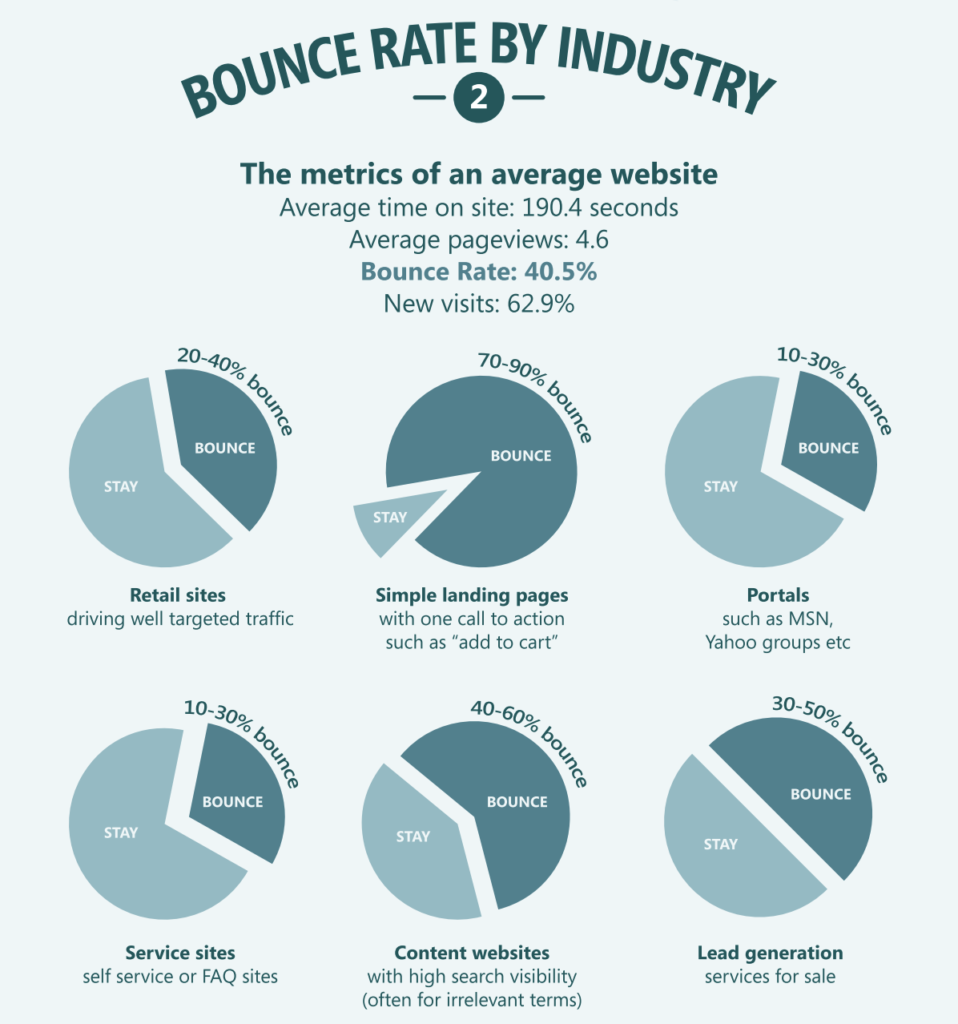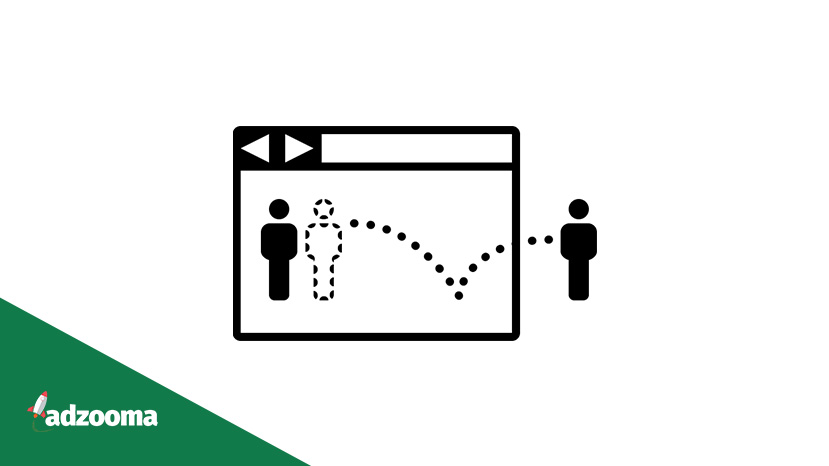When it comes to web analytics, bounce rate is a source of deep discussion.
- How do you measure bounce rate?
- Is it an accurate metric?
- Should it be used in reports?
While we won’t be diving into those questions in this article, it is important to consider them as part of your strategy to ensure your reports give optimal data to your colleagues or clients. For this article, we’ll look at what makes a good bounce rate according to industry benchmarks and why, as well as that all-important definition.
What is bounce rate?
In her article “So Let’s Talk About Bounce Rate as a Ranking Factor”, Jess Peck asked colleagues on Twitter for their definitions of bounce rate and there were some critical nuances in the responses, relating to 3 general definitions:
- A bounce is when someone enters your site and immediately leaves
- A bounce is when a visitor only visits one page on your site
- A bounce is when someone enters a page and takes no action on that page
Jess goes in-depth into the pros and cons of each, which I won’t do, but Google’s official definition is the following:
“Bounce rate is single-page sessions divided by all sessions, or the percentage of all sessions on your site in which users viewed only a single page and triggered only a single request to the Analytics server. These single-page sessions have a session duration of 0 seconds since there are no subsequent hits after the first one that would let Analytics calculate the length of the session.”
There’s also a variation of that on the Tracking Code Overview page for Google Analytics:
“Bounce rate is referred to as a single-page session to your site, but is strictly defined as a single interaction request during a user session. For this reason, a bounce rate for a page is also affected by eCommerce transactions and event tracking requests. This is because these features co-exist with page tracking and, when they are triggered, they result in additional interaction requests to the Analytics servers.”
As for Jess, I will use the above definition, defining bounce rate as a single-page session where someone leaves immediately without any additional page interaction. Think of it like picking up a magazine in a newsagent after checking the cover and putting it straight back without opening.
How to measure bounce rate
Bounce rates are a percentage of the number of one-page sessions over the total number of visits. So if there were 100 visits to a page and 90 of those were one-page sessions, the bounce rate for that page would be:
90 one-page visits ÷ 100 total visits = 0.9 or 90% bounce rate
Is bounce rate an effective metric?
Now, there is a lot of debate on whether bounce rate is an effective traffic metric. The point of a bounce rate is to track site engagement—are people accessing multiple pages on a site as part of their site visit. That’s where pages per session would come in as an additional metric.
But bounce rate comes with an unintentional bias towards information sites. In an era of “zero-click Google searches”, the perception is that people search for queries and want immediate answers. Someone looking for a definition of bounce rate may come to this page, find a satisfactory answer and leave without reading the rest. Does that make my page “bad” or did I fulfil the requirement? Bounce rate can’t necessarily tell you.
That’s why bounce rate on as a sole metric isn’t as effective compared to it being part of related metrics, like pages per session and session duration, especially if a bounce counts as a single-session visit with no activity for 30 minutes. By that, you could read a page for 30 minutes and leave, which would be amazing but count as a bounce, which wouldn’t.
Average bounce rate by industry
I’ve gone into the philosophical aspects of bounce rate but in order to define a “good” bounce rate, we need to look at averages across different industries as every site is different. As the owner of a cooking supplies company, you can’t compare yourself to a news site as they serve different intents.
By comparing a site with another one within the industry, you can judge the bounce rate more efficiently.
A general range for all satisfactory bounce rates is between 30%-70%.
However, finding accurate benchmarks is difficult due to the age and quantity of studies trying to find them. There are also different segments used for benchmarks such as device type, channel, and website type. For the purposes of this article, I will be listing the two more commonly cited benchmark studies so you have a range to compare your bounce rates.
Note: as there aren’t any additional statistics such as variance to go with these averages, don’t treat them as hard-and-fast rules.
CustomMediaLabs
- 20% – 45% for e-commerce and retail websites
- 25% – 55% for B2B websites
- 30% – 55% for lead generation websites
- 35% – 60% for non-eCommerce content websites
- 60% – 90% for landing pages
- 65% – 90% for dictionaries, portals, blogs and generally websites that revolve around news and events
Kissmetrics [link to PDF]

- 10%–30% for service sites – self service or FAQ sites
- 10%–30% for portals such as MSN, Yahoo Groups, etc.
- 20%–40% for retail sites driving targeted traffic
- 30%–50% for lead generation – services for sale
- 40%–60% for content websites with high search visibility
- 70%–90% for simple landing pages with one call-to-action such as “add to cart”
What to do when your bounce rate is “too high”
Now that you have a range to work with, it’s time to measure yourself amongst your industry peers. There’s always room for improvement but if you’re in the middle, improving bounce rate isn’t a high priority. The issue comes when you’re way over the upper limit—it could be a sign of underlying problems.
Here are 3 diagnostic techniques to find the root cause:
1. Run a heatmap
A heatmap is a cool (pardon the pun) way of observing user behaviour on a site by showing the most commonly visited sections of a page with a warm/cool spectrum:
- The most visited sections are redder or warmer
- The least visited sections are bluer or cooler
By running a heatmap, you will be able to use the warm/cool spectrum to see which parts of the page got the most attention, and identify potential underlying issues that your page might have.
Read: 10 Free CRO Tools To Use In 2020
2. Try split testing
A/B testing, also known as split testing, is the process of conducting testing in a bid to lower and improve your conversions, which go hand-in-hand with bounce rate.
The basic idea here is that you publish two versions of a page, with slightly different variations, and analyse the differences in your chosen metrics (in this case, the bounce rate). This can indicate what might be lacking that is impacting your bounce rate.
3. Improve page speed
Page speed is a big indicator that you might have issues; a slow and unresponsive page is not going to see many page conversions, and will lead to a high bounce rate. There are a few things you can do to improve your page speed, and some of the best ways include reducing redirects, enabling compression, improving your server response time, and optimizing any images you might have.
You can use Adzooma’s SEO Performance Report to test the speed of your website and you’ll receive a list of actions you can take to prevent anything slowing your website down.
Just login to your Adzooma account and under Reports at the top, click SEO Performance Report to get started. If you’re not an Adzooma user, you can sign up for free here and access this feature.
Further resources
- 11 Reasons Your Website Can Have a High Bounce Rate
- Bounce Rate: Everything You Want to Know and More
- Predicting bounce rates in sponsored search advertisements
- Session Duration, Avg
- How to Optimise Your Site with Google Analytics Data
- 6 Tips To Create The Best Landing Page
Conclusion
There is a lot to think about when it comes to bounce rate. But once you’ve settled on a definition and used it with other meaningful metrics as part of your reporting and overall strategy, it can become more useful.




